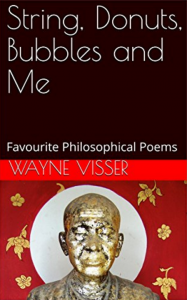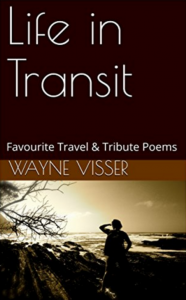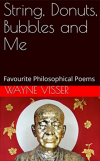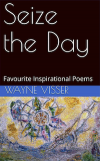I know I can and yet I don’t
I know I will and still I won’t
It’s in my hand, beyond my grasp
The future speaks of what is past
I know the when, the why and how
But what becomes of here and now?
Wayne Visser © 1988
Book
String, Donuts, Bubbles and Me: Favourite Philosophical Poems
 This creative collection, now in its 3rd edition, brings together philosophical poems by Wayne Visser. In this anthology, he muses on subjects ranging from space, angels and destiny to time, science and meaning in life. According to scientists / The world’s made of string / That buzzes and fuzzes / Or some such strange thing / It’s also a donut / That curls round a hole / With middles and riddles / Just like a fish bowl / And there’s no mistaking / It’s more than 3-D / With twenty or plenty / Dimensions unseen / Still others insist / It’s really a bubble / That’s popping and bopping / Through the lenses of Hubble. Buy the paper book / Buy the e-book.
This creative collection, now in its 3rd edition, brings together philosophical poems by Wayne Visser. In this anthology, he muses on subjects ranging from space, angels and destiny to time, science and meaning in life. According to scientists / The world’s made of string / That buzzes and fuzzes / Or some such strange thing / It’s also a donut / That curls round a hole / With middles and riddles / Just like a fish bowl / And there’s no mistaking / It’s more than 3-D / With twenty or plenty / Dimensions unseen / Still others insist / It’s really a bubble / That’s popping and bopping / Through the lenses of Hubble. Buy the paper book / Buy the e-book.


 This creative collection, now in its 2nd edition, brings together travel and tribute poems by Wayne Visser. The anthology pays tribute to the likes of Nelson Mandela, Maya Angelou, Barack Obama, Antoni Gaudí & Leonardo da Vinci, and reflects on travels ranging from China and South Africa to Ecuador and Russia. Life is lived in the in-between / In transit / Between coming and going / Between staying and moving on / Between here and there / And what we call home / What we call settled or contented / Is merely a resting place / A station for refuelling / A nexus for reconnecting / A junction for changing direction.
This creative collection, now in its 2nd edition, brings together travel and tribute poems by Wayne Visser. The anthology pays tribute to the likes of Nelson Mandela, Maya Angelou, Barack Obama, Antoni Gaudí & Leonardo da Vinci, and reflects on travels ranging from China and South Africa to Ecuador and Russia. Life is lived in the in-between / In transit / Between coming and going / Between staying and moving on / Between here and there / And what we call home / What we call settled or contented / Is merely a resting place / A station for refuelling / A nexus for reconnecting / A junction for changing direction.  This creative collection, now in its 3rd edition, brings together philosophical poems by Wayne Visser. In this anthology, he muses on subjects ranging from space, angels and destiny to time, science and meaning in life. According to scientists / The world’s made of string / That buzzes and fuzzes / Or some such strange thing / It’s also a donut / That curls round a hole / With middles and riddles / Just like a fish bowl / And there’s no mistaking / It’s more than 3-D / With twenty or plenty / Dimensions unseen / Still others insist / It’s really a bubble / That’s popping and bopping / Through the lenses of Hubble.
This creative collection, now in its 3rd edition, brings together philosophical poems by Wayne Visser. In this anthology, he muses on subjects ranging from space, angels and destiny to time, science and meaning in life. According to scientists / The world’s made of string / That buzzes and fuzzes / Or some such strange thing / It’s also a donut / That curls round a hole / With middles and riddles / Just like a fish bowl / And there’s no mistaking / It’s more than 3-D / With twenty or plenty / Dimensions unseen / Still others insist / It’s really a bubble / That’s popping and bopping / Through the lenses of Hubble.  This creative collection, now in its 3rd edition, brings together favourite inspirational poems by Wayne Visser. The anthology takes us on a journey through the peaks and troughs of life, celebrating the indomitable human spirit.. It includes many old favourites like “Poets Must Be” and “Chasing the Blue”, as well as brand new poems like “The Writer” and “Making Ripples”. Sages through the ages wisely say: / Carpe Diem – seize the dawning day / Oh, would that I could assuage that thirst / But the day conspires to seize me first! / With the hurry and scurry / Of home’s frantic flurry / And the hustle and bustle / Of work’s tangled tussle.
This creative collection, now in its 3rd edition, brings together favourite inspirational poems by Wayne Visser. The anthology takes us on a journey through the peaks and troughs of life, celebrating the indomitable human spirit.. It includes many old favourites like “Poets Must Be” and “Chasing the Blue”, as well as brand new poems like “The Writer” and “Making Ripples”. Sages through the ages wisely say: / Carpe Diem – seize the dawning day / Oh, would that I could assuage that thirst / But the day conspires to seize me first! / With the hurry and scurry / Of home’s frantic flurry / And the hustle and bustle / Of work’s tangled tussle.